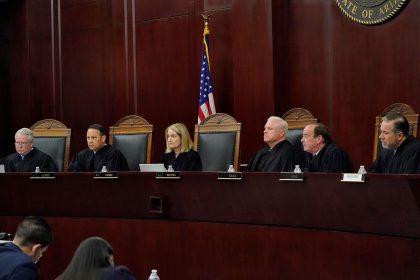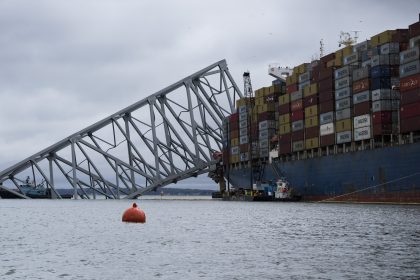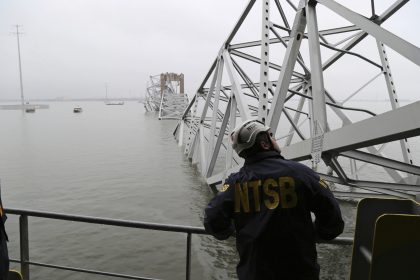Meet the New San Diego Border Barrier
Just Behind the Old San Diego Border Barrier
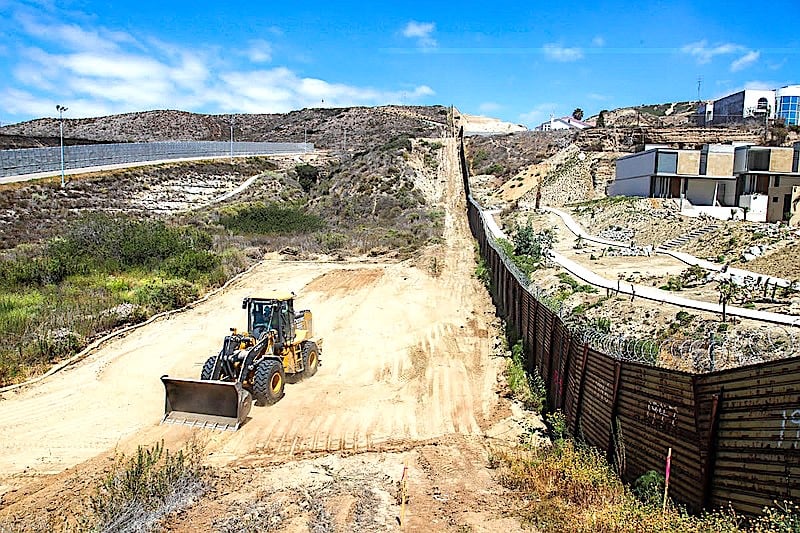
It’s kind of like a bait-and-switch along 14 miles of the San Diego border barrier, or maybe similar to the new and improved status sometimes awarded to reconstituted cereal brands.
Or call it peaches, as President Trump said for all he cares in early January.
You know how some people double wrap leftover food. Using previously allocated border funds, the Trump Administration was double-wrapping the border this week.
Construction began Monday on a second layer of barrier along the Mexican border. This consisted of the first panels with steel bollards 18-to-30 feet high replacing a steel-mesh fence in back of a 30-foot-high steel bollard barrier, according to U.S. Customs and Border Protection (CBP) officials. The steel posts will be topped with a steel anti-climbing plate.
The poles will replace eight- to 10-foot tall scraps of corrugated Vietnam War-era metal installed at the border during the 1990s to prevent pedestrian and vehicles crossings. The scraps needed to be replaced with a “higher performing design,” according to CBP.
The project area begins roughly one half-mile from the Pacific Ocean and extends eastward to the base of Otay Mountain. Other projects are underway in Calexico and New Mexico, where two-mile and 20-mile stretches of border, respectively, are being upgraded, according to City News Service.
The first layer of steel-mesh fencing worked well when it was built about a decade ago, but it is now often breached with powerful battery-operated saws sold in home improvement stores. Border Patrol agents said some tools enabled crossers to cut through the fence in 20 seconds. An average of 540 cuts were made in the fence per year, agents said.
Trump inherited barriers covering about one-third of the border. His administration has awarded $1 billion in contracts to cover 97 miles, the vast majority of it to replace existing barriers. Work on his first extension is scheduled to begin later this month 14 miles in Texas Rio Grande Valley.
The Border Patrol issued a news release falsely asserting that this was part of the Trump administration’s proposed “border wall.”
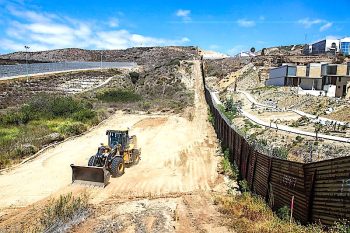
The bollards — basically vertical posts, shorter versions mainly used in road traffic control — were constructed by SLSCO Ltd. of Galveston, Texas under a $147 million contract awarded last December. That contract was awarded as part of $166.8 million in fiscal 2018 omnibus funds for work in San Diego, Calexico and Tecate by the company.
This was part of a March 2018 funding bill, passed with support from both parties, providing $1.6 billion to build a system that included replacements and new barriers, including levees, steel bollards with narrow spacing between each post and, in some locations, both concrete walls and bollards.
The lawmakers language was notably narrow, limiting the administration to using existing barrier designs instead of the new wall prototypes Trump had built in San Diego near the border, according to the Associated Press.
NBC News reported in January that prototypes along the San Diego border were found to be easily breached as well. KPBS shared a redacted copy of the report showing that the prototypes could be breached, but it did not include photos of the damage. A test of the steel prototype for the border wall showed it could be sawed through, NBC News reported.
Ralph DeSio, a Customs and Border Protection spokesman, told KPBS at the time that the prototypes “were not and cannot be designed to be indestructible,” but were made to impede or deny efforts to scale, breach, or dig under such a barrier, giving agents time to respond.”
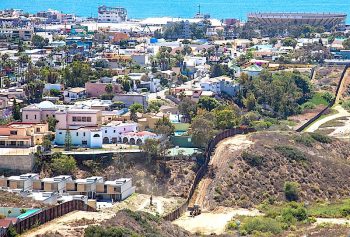
DHS spokeswoman Katie Waldman told The Hill that the design of the wall currently under construction was informed by the prototypes, but does not replicate those designs.
The steel bollard design is internally reinforced with materials that require time and multiple industrial tools to breach, thereby providing US Border Patrol agents additional response time to affect a successful law enforcement resolution, Waldman said.
She added that a damaged steel bollard can be repaired quickly and cost-effectively, and said a barrier being breached allows Border Patrol agents more time to respond to the entry attempt.
According to inewsource, a nonprofit, nonpartisan news organization working in conjunction with San Diego State University: From the 1970s through the mid-1990s, the San Diego region had the greatest share of illegal entries along the U.S.-Mexico border, peaking in 1991 with half of all apprehensions. As fencing and enforcement increased in the area, apprehensions shifted east. That trend continues today.
Building on federal data from our Americas Wall project along with KPBS, inewsource found that by 2014, the San Diego regions share of apprehensions had dropped to less than 7 percent, the lowest it’s been in the past six decades.
For fiscal 2018, Border Patrol reported more than 38,000 apprehensions in the San Diego region, up from the year before but well below the regions peak of nearly 630,000 apprehensions in 1986.
Lawsuits, lawsuits, lawsuits
The state of California and major environmental groups sued, unsuccessfully, over wall projects in the state, saying the administration overreached when it waived environmental reviews to speed construction. Last week, a federal appeals court upheld a judge’s decision siding with the president.
“President Trump is manufacturing a crisis and declaring a made-up ‘national emergency’ in order to seize power and undermine the Constitution,” said California Gov. Gavin Newsom in a statement. “This ’emergency’ is a national disgrace.”
The latest groundbreaking came three days after Trump declared a national emergency to build his proposed border wall with Mexico. The American Civil Liberties Union on Tuesday filed the fourth legal challenge to the emergency declaration.
California and 15 other states filed a lawsuit Monday against President Donald Trump’s emergency declaration to fund a wall on the U.S.-Mexico border. Trump declared a national emergency to fulfill his promise of completing the wall. He long past dropped his promise that Mexico would pay for a concrete wall from sea-to-sea.
The move, should it stand, allows the president to bypass Congress to use money from the Pentagon and other budgets for unallocated purposes.
The states say diversion of military funding to wall-building will hurt their economies and deprive their military bases of needed upgrades. They say taking away funds from counter-drug efforts for the wall will also cause damage. California and New Mexico, the two Mexican border states in the lawsuit, say the wall will harm wildlife.
California Attorney General Xavier Becerra released a statement Monday saying the suit alleges the Trump administration’s action violates the Constitution.
“President Trump treats the rule of law with utter contempt,” Becerra said. “He knows there is no border crisis, he knows his emergency declaration is unwarranted, and he admits that he will likely lose this case in court.”
Joining California in filing the lawsuit are the attorneys general of Colorado, Connecticut, Delaware, Hawaii, Illinois, Maine, Maryland, Michigan, Minnesota, Nevada, New Jersey, New Mexico, New York, Oregon, and Virginia. All the states involved in the lawsuit have Democratic attorneys general.
















